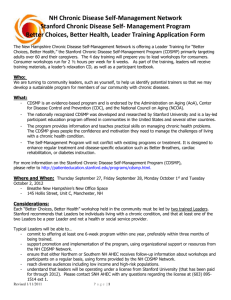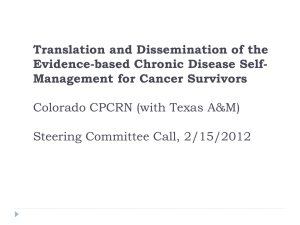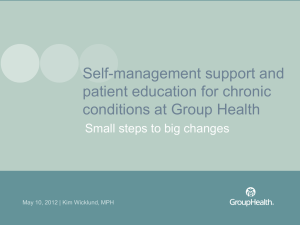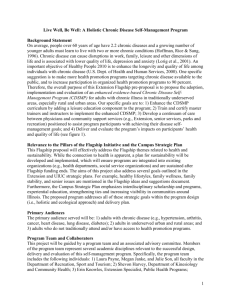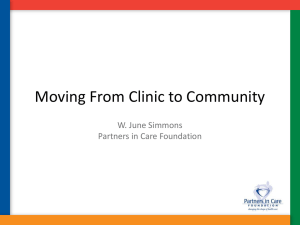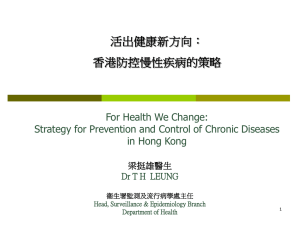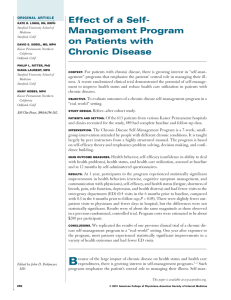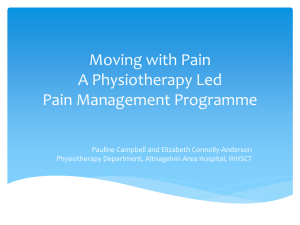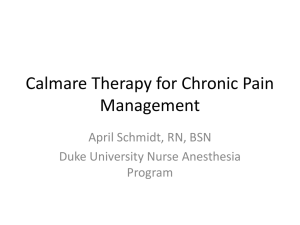Nicole Flowers, CDC - ACHIEVE Healthy Communities
advertisement
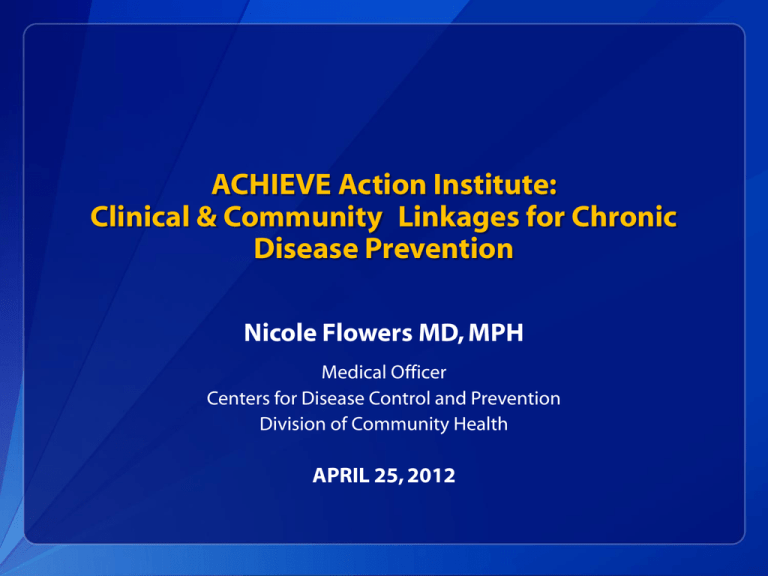
ACHIEVE Action Institute: Clinical & Community Linkages for Chronic Disease Prevention Nicole Flowers MD, MPH Medical Officer Centers for Disease Control and Prevention Division of Community Health APRIL 25, 2012 Learning Objectives Describe the burden of chronic disease and approaches to reducing the burden. Understand how community efforts can work synergistically with clinical levers to address chronic disease. Identify options for supporting individuals with chronic disease in your community. Chronic Diseases 145 million Americans are affected Responsible for 7 of every 10 U.S. deaths Cause major limitations in daily living for 1 of 10 Americans Account for ~75% of U.S. medical costs Are inequitably distributed across the population Chronic Diseases and Related Risk Factors Leading Causes of Death* United States, 2000 Actual Causes of Death† United States, 2000 Heart Disease Tobacco Cancer Poor diet/ Physical inactivity Stroke Alcohol consumption Chronic lower respiratory disease Microbial agents Unintentional Injuries Toxic agents Diabetes Motor vehicles Pneumonia/influenza Firearms Alzheimer’s disease Sexual behavior Kidney disease Illicit drug use 0 5 10 15 20 25 Percentage (of all deaths) 30 35 0 5 10 15 Percentage (of all deaths) * Miniño AM, Arias E, Kochanek KD, Murphy SL, Smith BL. Deaths: final data for 2000. National Vital Statistics Reports 2002; 50(15):1-120. † Mokdad AH, Marks JS, Stroup DF, Gerberding JL. Actual causes of death in the United States, 2000. JAMA. 2004;291(10):1238-1246. 20 Factors that Affect Health Examples Smallest Impact Counseling & Education Clinical Interventions Long-lasting Protective Interventions Largest Impact Changing the Context to make individuals’ default decisions healthy Socioeconomic Factors Eat healthy, be physically active Rx for high blood pressure, high cholesterol, diabetes Immunizations, brief intervention, cessation treatment, colonoscopy Fluoridation, 0g trans fat, iodization, smokefree laws, tobacco tax Poverty, education, housing, inequality Imagine a typical chronically ill patient who sees his doctor half an hour every three months. These four encounters each year—the physician’s opportunity to counsel, diagnose, and treat—constitute only 0.02% of this patient’s life. For all the rest—the 99.98% of the time that the patient is elsewhere, making decisions about his health in the context of his culture, family, and community— the doctor’s impact on the patient’s choices is minimal…. That 99.98% belongs to community medicine, to population health, and to public health. Jarris et al, Acad Med. 2011;86:1347. Imagine a typical chronically ill patient who sees his doctor half an hour every three months. These four encounters each year—the physician’s opportunity to counsel, diagnose, and treat—constitute only 0.02% of this patient’s life. For all the rest—the 99.98% of the time that the patient is elsewhere, making decisions about his health in the context of his culture, family, and community— the doctor’s impact on the patient’s choices is minimal…. That 99.98% belongs to community medicine, to population health, and to public health. Jarris et al, Acad Med. 2011;86:1347. National Prevention Strategy • Extensive stakeholder and public input • Aligns and focuses prevention and health promotion efforts with existing evidence base • Supports national plans 8 National Prevention Strategy 9 Clinical and Community Linkages to Address Chronic Disease Clinical Preventive Services Procedures, tests, counseling, or medications Aimed at preventing the onset or progression of a health condition or illness Clinical and Community Preventive Services Linking clinical domain and community resources for systems change to promote improved health outcomes in the community. Expanded Chronic Care Model Medical Management SelfManagement Ongoing Support Critical Elements of Disease Management Pharmacists Can Improve Care and Reduce Costs Supporting medication adherence Improving the use of medications Improving treatment outcomes Helping patients with self-management Community Health Workers • Liaison between health systems and communities • Facilitate access to and improve quality and cultural competence of medical care • Build individual and community capacity for health by: • • • • Increasing health knowledge and self-sufficiency of the patients Serving as community health educators Providing social support Advocating for the health care needs of patients and communities Sample community activities to support teambased care (TBC) Influence coverage for TBC in private health plans, among self-insurers or public health plans. Ensure standardized curriculum or protocols for health care extenders. Support jurisdiction-wide defining of the scope of practice for the health care extenders Gather and disseminate information about the return on investment for utilization of team-based care approaches Increase awareness among patients with chronic disease about the availability of CHWs or pharmacists as healthcare extenders State Example - Maryland • P3 (Patients, Pharmacists, Partnership) is a program among worksites and community pharmacies using pharmacists to provide chronic disease self-management • Participants have seen a sustained reduction in A1C , blood pressure, and lipids State Examples • Minnesota passed legislation in 2009 to make CHW services reimbursable under Medicaid and the state regulates CHW training, supervision, enrollment criteria, and billing • Massachusetts’ broad-based policies, consistent and powerful advocacy from the CHW workforce, and partnership with state public health partners secured the ongoing integration of CHWs into health care systems Chronic Disease Self-Management Program Low-cost, community-based class for people with chronic diseases developed at Stanford University A CDC meta-analysis of CDSMP showed improvements in fatigue, depression, health distress, etc. CDC’s Arthritis Program funds 12 state arthritis programs that can offer CDSMP as a proven intervention CDC’s Diabetes program and Heart Disease and Stroke Prevention program have refunded programs for CDSMP Sample Activities of Community Organizations to support CDSMP Possible PSE activities: Facilitate increased uptake of CDSMP sites. Sites should be linked to a health care delivery system Campaign to increase awareness about availability and benefits of CDSMP Support provider referrals to CDSMP Facilitate development of infrastructure for better communication and data sharing between CDSMP and providers. Engage populations with health disparities State Example - Oregon Worked with other state agencies, local health dept, health care providers, social service agencies, and CBOs to create a sustainable infrastructure for delivering CDSMP Best estimates over four years show 557 emergency room visits avoided, saving $634,980 and 2,783 avoided hospital days, saving $6, 501,088 Currently engaged in discussions with public employees and educators’ benefit boards on inclusion of CDSMP as a covered benefit Community – Clinic Partnership Community Insurers Employers } Clinic Partnership Zone Reimbursement Informed Population Screening for High Risk Strong Community Organizations Proactive Practice Team Diagnosis of Prediabetes Structured Lifestyle Programs Healthy Public Policy Supportive Environments Total Population Prediabetes Decision Support Information Systems Regular Glucose Monitoring Diabetes Informed, Activated Patients Complications EnhanceFitness • Evidence based, community based exercise program developed by the University of Washington PRC • Increases strength, boosts activity, elevates mood • One of six physical activity programs recommended by CDC Arthritis Program • Offered by Group Health as a free benefit to all its Medicare enrollees since 1998 • In 2011 the YMCA began offering EF at Ys in 8 states and will continue expansion efforts Community-Clinical Linkages How can you support chronic disease prevention in your community ?
